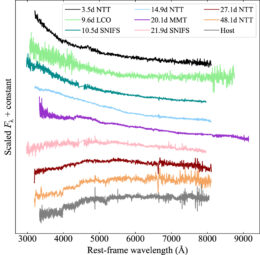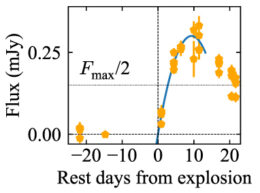Discovery of a bright, rapidly evolving source led researchers to propose a new class of transients called luminous fast coolers. The physical origin of these rare events, which arise in quiescent elliptical galaxies rather than spiral galaxies like many transients, is still unknown.
Something New in the Universe
In 2022, the Asteroid Terrestrial impact Last Alert Survey (ATLAS) detected a rapidly brightening source in a quiet elliptical galaxy. The event, labeled AT 2022aedm, was tentatively tagged as a supernova at first, but its fast evolution soon revealed it to be something other than an ordinary exploding star. In a recent research article, Matt Nicholl (Queens University Belfast) and collaborators described the object’s dynamic light curve, investigated its spectrum, and pondered its origins.

Spectra of AT 2022aedm at multiple points in time after discovery, plus a spectrum of its host galaxy (gray). Click to enlarge. [Adapted from Nicholl et al. 2023]
Assembling the Puzzle Pieces
In the weeks after AT 2022aedm’s discovery, Nicholl’s team collected data to characterize the event’s swiftly changing light curve. Optical data show that it reached its peak brightness just nine days after its onset, rocketing up to a spectacular peak magnitude of −21.5, before fading nearly as quickly. To put that into context, this means that this single event was about 2.5 times brighter than our entire galaxy! This incredible brightness placed AT 2022aedm in the realm of superluminous supernovae, which make up just 0.1% of supernovae. But other pieces of the puzzle didn’t fit this explanation; AT 2022aedm’s brightness increased and decreased too quickly and its spectrum never gained the tell-tale broad spectral lines of a supernova.
Even stranger than AT 2022aedm‘s light curve and spectrum is where it was found: in a massive elliptical galaxy with very little active star formation. Most core-collapse supernovae happen in lower-mass spiral galaxies, where ongoing star formation is constantly creating new massive stars to fuel these explosions, and superluminous supernovae especially seem to be confined to star-forming spirals.
A Class of Three

The location of AT 2022aedm within its host galaxy is marked with magenta crosshairs. [Adapted from Nicholl et al. 2023]
Despite the similarities between the light curves and spectra of the three events, Nicholl and collaborators were unable to find a physical explanation that fit all three events. Among the options considered were tidal disruption events (when a star is shredded by a massive black hole), exploding white dwarfs, supernovae giving birth to extremely dense, highly magnetized stellar remnants called magnetars, and colliding neutron stars. Each of these scenarios encountered serious roadblocks during the team’s analysis, but the team found promising signs that with further modeling, either a star interacting with a stellar-mass black hole or a shock colliding with a gas cloud could someday explain the origins of these newly described events.
Citation
“AT 2022aedm and a New Class of Luminous, Fast-cooling Transients in Elliptical Galaxies,” M. Nicholl et al 2023 ApJL 954 L28. doi:10.3847/2041-8213/acf0ba

